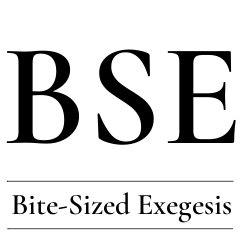In John 1:15 John the Baptist identifies Jesus in a way that is usually translated “The one who is coming after me ranks ahead of me, because he existed before me.” I propose that all three clauses should be translated temporally something like, “The one coming after me has existed since before me, because was first before me.”
Category Archives: Studying the Bible
Psalm 5: A Morning Devotional Prayer or Something Else?
The KJV rendering of Psalm 5:3 can give one the impression that this is a prayer of general devotion to be recited in the morning. However, a careful reading of the psalm shows that quite a bit more is going on here.
Principles For Reading Hebrew Parallelism in English
To get the most out of Hebrew poetry when reading it in English: (1) look for subtle comparison and contrast, not bland repetition; (2) look for layered parallels; (3) look for movement in the parallels. Want to know more? Read this article.
The Challenge and Importance of the OT’s Prophetic Poetry
Reading the poetic portions of the Old Testament in English, especially in the Prophets, can be challenging. But the fact is that the more familiar one becomes with the poetic sections of the Prophets, the more one sees that they are absolutely, vitally central to the NT. In the end, the way to make OT poetry interesting and understandable is not by retreating from it but by studying it even more intensely using all the imaginative and scholarly resources at your disposal.
Review: Biblical Hebrew Vocabulary by Conceptual Categories
Biblical Hebrew Vocabulary by Conceptual Categories is a lexical aid for students and teachers of Biblical Hebrew. This book is highly versatile with many uses not only for beginning students but also for intermediate and advanced students as well as for teachers.
Review: The CEB Study Bible
The CEB Study Bible is a well designed and excellently written study bible that distinguishes itself from the crowd by taking a more open-minded approach to the historicity, date of composition, and authorship of debatable sections of the Bible. However, the appeal of this study bible may be narrowed by its inextricably being tied to the CEB, a translation whose eager pursuit of a laudable goal (to produce a truly fresh translation free from wrongly embedded conservative Evangelical ideas) unfortunately results in uneven quality.
The Strengths and Weaknesses of the Common English Bible
The defining characteristic of the Common English Bible translation is its willingness to revisit and re-render traditional translations of well known biblical passages. While this is often a strength, it seems to be driven by a desire among those who commissioned the translation to distance themselves from conservative evangelicalism, and in many places this results in replacing good (albeit traditional) translations with highly questionable ones for no apparent scholarly reason.
“Your Bible Study Tool Belt” Workshop 3/31/17
BSE is partnering with The Promise Church, Houston, to present “Your Bible Study Tool Belt”, a workshop that teaches you how to use commonly available reference tools to enhance your personal Bible study.
Studying the Bible: To Love It is To Know It
To really know someone or something one must first love that someone or something. This applies both to human relationships and to Bible study.
Q&A – Why Do Some Christians Have Longer/Shorter Bibles?
Question: AH! I just discovered that some Christian groups have more/fewer books in their Bible, and now I’m afraid I can’t believe anything anymore! What do I do? Short Answer: DON’T PANIC! We all agree about the New Testament. In the Old Testament … it’s complicated, but the positions are all reasonable.







